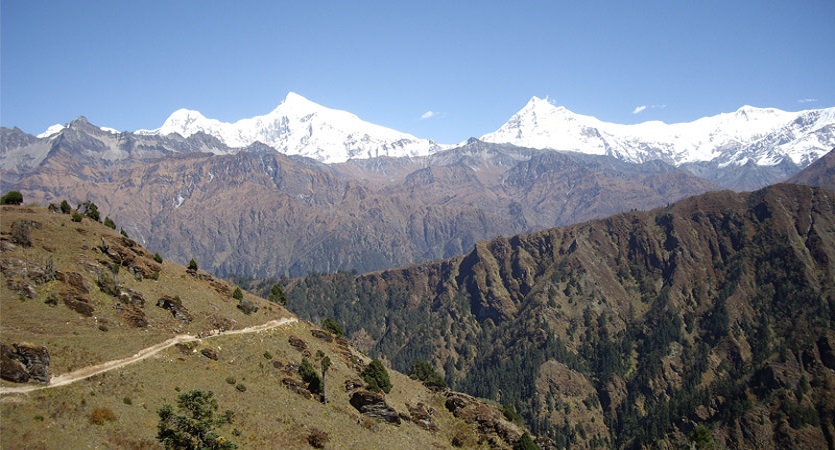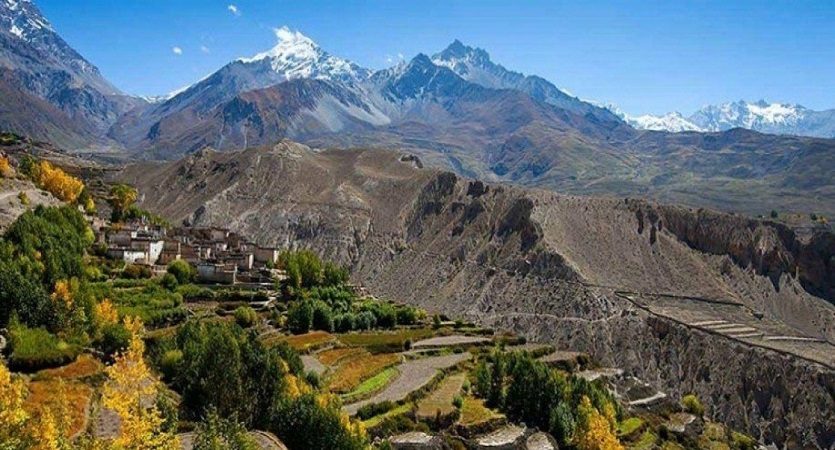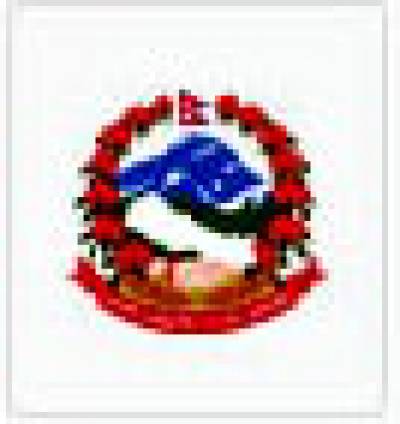GUERRILLA TREK
A region where Maoist revolutionaries called home!
An interesting historical pilgrimage and a stunning natural wonderland combined into this region. This is a distinctly different trek that follows the path of the Maoist guerillas during Nepal’s insurgency from 1996 -2006. It is new and in a remote area of western Nepal in the Rukum and Rolpa regions. You will feel and hear of how villagers became an inescapable part of this war. This is a historical and rewarding adventure into a region rich in culture and natural beauty, with raging rivers, waterfalls, lakes such as Kamala Daha (Lotus Lake), dense jungle, caves and wildlife.
It is ironic that the Dhorpatan Hunting Reserve, the only one in Nepal, is located within this area. It is also where Yarshagumba, a natural type of Viagra is found.
It is home to various ethnic people, such as Dalit, Gurung, Magar, Newar, Kshetri and Brahmin each with its own cultural beliefs and customs.
The trek begins in the town of Beni in the Magdi district passing through Baglung and through the Dhorpatan Hunting Reserve with its dense pine forests, and then progresses to the districts of Rukum and Rolpa. The altitude ranges from 800m at Chaurijahari to the 7245m Pyutha Himal (7245m range). Along the trail are some incredible jaw-dropping views of the Dhaulagiri Range and expansive views over meadows where buffalo and cows graze. It has been gaining popularity due to a map and trekking guide published in 2012 by the Maoist leader Puspa Kamal Dahal (Prachanda).
Key features of Guerrilla Trek
- Myagdi-Baglung trek & rich biodiversity & wildlife.
- Less crowded new destination.
- The largest Rhododendron forest in the world.
- Dhorpatan Hunting Reserve – the only one in Nepal.
- A vast collection of ethnic communities: Thakali, Dalit, Tibetan, Chhetri, Gurung, Brahmin, Newar, Kshetri and Magar.
- Historically significant guerilla trail of the Maoist insurgents.
ITINERARY
Day 1 : Arrival in Kathmandu and transfer to hotel.
On your arrival at Kathmandu Tribhuvan International Airport, you will be met by Sherpa Expedition and trekking staff and transferred to your respective hotels followed by a briefing regarding Dhaulagiri trek, hotels, lodges on the route and the dos and don’ts.
Day 2 : Drive from Kathmandu to Beni (700m) Duration: 7-9 hours.
We set out on a seven to nine-hour drive from Kathmandu to Beni, depending on the means of transport.
Day 3 : Trek from Beni to Takam (1665m) Duration: 6-7 hours.
Our day begins with a 24km road trip from Beni to Darbang on an unsealed road. Beni is the headquarters of the Myagdi District. From Darbang we start trekking under the shadow of the Guraj Himal. Tonight we will either stay in a tent or homestay.
Day 4 : Trek from Takam to Lamsung (2250m) Duration: 5-6 hours.
Today we trek for six to seven hours along a trail that becomes more stunning by the hour. Along the trail you can listen and learn from villagers who experienced life under the Maoists. Tonight we will stay at Lamsung Village.
Day 5 : Trek from Lamsung to Gurjhagat (3020m) Duration: 5-6 hours.
Leaving Lamsung we ascend through a thick pine forest that is home to many musk deer. On the ridge, we have a panoramic view of pastureland and the Dhaulagiri Range and in the west Churen Himal. After six hours on the trail, we arrive at Gurjhagat Village where we stay the night.
Day 6 : Trek from Gurjhagat to Dhorpatan (2860m) Duration: 5-6 hours.
The trail of five to six hours today takes us through a former Tibetan refugee camp that was constructed by the Swiss in the 1950s. We also cross into the Dhorpatan Hunting Reserve that is home to various species, such as mountain goat and blue sheep. Tonight we will stay here at Dhorpatan Village overnight.
Day 7 : Trek from Dhorpatan to Nisi Dhor (2620m) Duration: 5-6 hours.
We have a five-hour trek ahead of us today through an area abundant with birdlife, such as Nepal’s national emblem the pheasant. This is a seasonal grazing ground during the rainy season. We will stay overnight at Nisi Dhor.
Day 8 : Trek from Nisi Dhor to Tallo Sera; Duration: 5-6 hours.
We have a five to six-hour trek today and head through dense forested areas. We will arrive at Tallo Sera where we will stay overnight.
Day 9 : Trek from Tallo Sera to Rujhikhola; Duration: 6-7 hours.
Today we follow the trail for six to seven hours before reaching Rujhikhola where we stay the night.
Day 10 : Trek from Rujhikhola to Thabang (1975m) Duration: 5-6 hours.
A five hours trek takes to Thabang, well known as the center of the Maoist revolution. The village suffered extensive damage during the uprising. The people here are extremely friendly and welcoming. Tonight we will stay here.
Day 11 : Trek from Thabang to Jaljala (3100m) Duration: 6-7 hours.
It will take us six to seven hours today to reach Jaljala. The highest point in Jaljala is Mt. Dharampani (3600m). There are some great views of and there is a great view from Api Saipal (7132m) to the west and Dhaulagiri in the east. Tonight we will stay at Jaljala.
Day 12 : Trek from Jaljala to Sulichaur (800m) Duration: 5-6 hours.
Today we follow the trail to Sulichaur in the Rolpa district which was a Maoist base during the ten-year insurgency. It is still home to Maoists and a good place to further your understanding of the insurgency. Tonight we will stay at Sulichaur.
Day 13 : Drive from Sulichaur to Kathmandu; Duration: 10-13 hours.
Today we have a 12 to 13-hour drive back to Kathmandu by bus.
Day 14 : Transfer to Tribhuvan International Airport.
Your adventure comes to an end today – but your memories will last a lifetime! Our company representative will take you to the airport approximately 3 hours before your scheduled flight. On your way home you'll have plenty of time to plan your next adventure.
SERVICES
Cost Included In Your Package
- Airport pick up and drop off by private vechile
- Kathmandu to Beni and Silachour to Kathmandu Transportation by Bus.
- Two night’s hotel accommodation in Kathmandu with breakfast (3-star hotel)
- Three night hotel accommodation in pokhara with breakfast.
- Best Possible Teahouse, lodge / Tent Camp accommodation during the trek
- All Standard Meals -3 Meals a day (breakfast, Lunch and dinner) during the trek
- Government License holder English Speaking Sherpa Expedition and Trekking’s experienced and qualified trek leader,(8 or above trekkers: 1 assistant guide) and porter to help trekkers luggage. (2 trekkers:1 porter "10 kg per trekker max limit")
- Strong, helpful Sherpa porters with proper safety equipment and walking equipment, his salary, food, accommodation, and insurance (one porter for two people).
- Coverage of Guides and Porters, Their meals, insurance, salary, lodging, transportation, flight and other necessary equipment.
- Annapurna Conservation Area Permit (ACAP) Fee.
- Trekkers Information Management System (TIMS) card fee.
- All government, Local taxes and official Expenses
- Assistance in arranging rescue operation in case of complicated health condition (funded by travel insurance)
- Sherpa Expedition and Trekking’s appreciation of certificate after the successful trek
- Oxygen meter to check your pulse and oxygen saturation and heart rate twice daily (Very useful to check Altitude Mountain Sickness(AMS) symptoms) which will ensure your health during the trek.
- Assistant guide for groups of 8 or more people.
Cost Excludes
- International flight airfare
- Nepal entry visa fee (easy to obtain the visa on arrival at Tribhuvan International Airport – Kathmandu). $30 USD for 15-day, $50 USD for 30 Days, and $125 USD for 90 Days visa.
- All Accommodation and meals in Kathmandu, before and after we start our journey
- Lunch and Dinner in pokhara.
- Extra night accommodation in Kathmandu due to early arrival or late departure, early return from the trek.
- Personal expense (shopping, snacks, boil bottle water, tea, coffee, hot water, hot and cold drinks, hot shower, Alcohol, Wi-Fi, telephone call, battery re-charge fee), extra porters etc
- Personal clothing and gear
- Travel insurance which has to cover emergency high-altitude rescue and evacuation compulsory
- Tips for guide and porters (Recommended by the Culture)
- Additional costs or delays caused by out of management control, for example, landslide, weather condition, itinerary modification due to safety concerns, illness, change of government policies, strikes etc.
- All the costs and expenses which are not listed in "cost includes" will be counted as Excludes
EQUIPMENTS
The following information will give you some idea about what you need to bring for the trek. It is important you do not forget the essential items, as this will determine your comfort and safety on the trek. Equally important is that you do not burden yourself with unnecessary equipment on the trek.
General
- All season sleeping bag and down Jacket (we can provide if you need it, but has to be returned after the trek)
- Duffle bag ( Sherpa Expedition & Trekking provide duffle bag during the trek but has to be returned after the trek)
- A wind and waterproof thin layered jacket (a must-have for morning and evenings above 3,000m)
- Daypack
Upper Body- Head / Ears / Eyewear
- A pair of half gloves
- A warmer hat that covers the ears
- Sunglasses
- Neckwarmer
- Sunscreen (35 to 60 SPF)
- Headlamp and an extra set of batteries
Hands
- A pair of half gloves for walking poles(if you prefer)
- Warmer shell gloves and liner
Upper Body
- long sleeve t-shirts
- Thermal tops
- wool jacket or pullover
- Sports bras for women and girls
- Water and windproof shell jacket
Lower Body
- Thermal underwear (especially trousers)
- windproof and waterproof trousers
- warmer trousers
- Comfortable trekking pants
- Extra casual sport pants
Footwear
- A pair of good waterproof trekking boots
- Pair of sandals
- 4-5 pairs of woolen socks
- Sock liners
- Light shoes and sneakers
- First Aid Kits and Medicines
- Assorted adhesive bandages (fabric preferred)
- Blister treatment cream or similar
- Insect / anti-itch ointment
- Ibuprofen or other pain-relief medication
- Diamox (125mg to 250mg tablets for altitude sickness)
- Warps, splints, and wound coverings butterfly bandage
- Water purifying pills
(Note our company guide will carry the medicines and first aid kits during the trek. However, we recommend you bring your personal first-aid kit as well)
Miscellaneous - but must useful on the trek
- 4 passport size photos with original passport
- Water bottle & filter
- Flight details (please make a copy and leave one pic at our office in KTM because in case you want to change your flight date)
- Bathroom kit (conform, should be included toilet paper, plastic bags, hand wipes, towel, and soap, etc.)
Extra things
- Comfortable trekking poles
- Quality energy dry foods (up to you)
- Power bank and music players
- Camera (memory card, chargers, and extra batteries)
GOOD TO KNOW
Accommodation
You will be accommodated in 3-star hotels in Kathmandu. During the trek, we will be staying at lodges/ teahouses. You may not find comfort and better quality teahouses -During the trek, We sleep in the very simple tea house/tent and our guides will pick the best Camping site with a nice view of the Himalaya.
Meals during the trek
In Kathmandu, your hotel includes breakfast, whereas all meals (breakfast, lunch, and dinner) will be provided during the trek. A staple food of these mountain regions are potatoes, oats, buckwheat, Sherpa stew and Tibetan bread. Sherpas started farming potatoes when the first seeds were introduced to the region in the early 90s. There is a limited choice of food at higher elevations and except many potato dishes. Potatoes are high in carbohydrates – an excellent source of energy needed at high altitudes.
Transportation
We use a private car for sightseeing and for the airport to hotel pick and drop off. We do not have to use public transportation or local buses during the trek.
Physical fitness
Guerilla Trek is a challenging trek where you often have to walk 6-7 hours a day. You need past experience of hiking or trekking but if you have done any kind of trekking activities then it is always a plus!. We have met people from all walks of life, shapes, and sizes who have completed the trek. The only difficult part is when altitude sickness strikes and the effect that it can have on your body. Before leaving for Nepal it is good if you can prepare yourself physically by increasing your stamina and oxygen intake.
Remember – The better prepared – the more enjoyable your trek!
MAP
PHOTOS/Videos
Departures
Select a departure month
Fill out the form below and a Travel Expert will reach out to create your perfect tour.
FAQS
What is the Guerilla Trek?
The Guerilla Trek is a unique and historically significant trekking route in Nepal. It follows the footsteps of the Maoist rebels during the Nepalese Civil War and provides an opportunity to learn about the country's recent history while enjoying the natural beauty of the region.
How long does the Guerilla Trek take?
The duration of the Guerilla Trek can vary depending on the specific itinerary and your fitness level. Generally, it takes around 10-14 days to complete the trek. This includes trekking through remote villages, dense forests, terraced fields, and experiencing the local culture and lifestyle.
Is the Guerilla Trek difficult?
The Guerilla Trek is considered a moderate to challenging trek, suitable for experienced trekkers with a good level of fitness. The trail involves steep uphill and downhill sections, walking on rugged and rocky terrain, and crossing rivers. Some parts of the trek can be physically demanding, so it is important to be prepared and have prior trekking experience.
What is the best time to do the Guerilla Trek?
The best time to do the Guerilla Trek is during the spring (March to May) and autumn (September to November) seasons. These months offer pleasant weather, clear skies, and beautiful landscapes. The monsoon season (June to August) should be avoided due to the possibility of heavy rainfall, leeches, and slippery trails.
Do I need a permit for the Guerilla Trek?
Yes, you will need a permit to trek in the Guerilla Trek area. The trek falls under the restricted area, so you will need to obtain a special permit called the "Restricted Area Permit." This permit can be obtained through a registered trekking agency in Nepal.
Is it necessary to hire a guide and porter for the Guerilla Trek?
While it is not mandatory to hire a guide and porter for the Guerilla Trek, it is highly recommended, especially due to the remote and less-traveled nature of the trail. A guide can provide valuable information about the trail, local culture, and historical significance. A porter can carry your heavy backpack, allowing you to trek with less weight and enjoy the journey more comfortably.
What are the accommodation and food options during the trek?
Accommodation during the Guerilla Trek is basic and mostly consists of teahouses or guesthouses along the trail. These provide simple rooms with shared facilities such as bathrooms and toilets. The teahouses also serve meals, including local and basic international cuisine. However, as the trek is less popular, the availability of food and accommodation may be limited in some areas.
Are there any altitude sickness risks on the Guerilla Trek?
The Guerilla Trek does not involve trekking to very high altitudes, so the risk of altitude sickness is minimal. However, it is still important to acclimatize properly, especially if you are coming from lower elevations. Take rest days, drink plenty of water, and listen to your body to avoid any altitude-related issues.
Can I do the Guerilla Trek solo?
While it is possible to do the Guerilla Trek solo, it is not recommended due to the remote and less-traveled nature of the trail. Having a guide can provide additional safety and navigation support, especially in areas where the trail may not be well-marked. It is also advisable to inform someone about your trekking plans and carry a reliable map or GPS device.
What should I pack for the Guerilla Trek?
Some essential items to pack for the Guerilla Trek include comfortable trekking shoes, lightweight and breathable clothing, a warm jacket, a hat, sunglasses, sunscreen, a water bottle, a first aid kit, trekking poles (optional), a good quality backpack, and a sleeping bag suitable for the expected temperatures. Additionally, pack appropriate gear for variable weather conditions and consult with your guide or trekking agency for any specific equipment requirements.
Latest Traveller’s Reviews
Travel experiences of our clients who recently returned from their trips.
100%
Based On 3 Reviews
Donna Wilkins
Australia
October 11, 2023
Guerrilla Trek with Shera Expedition
My friend and I had the adventure of a lifetime while trekking the Guerrilla Trek with Shera Expedition. This trekking company's professionalism and attention to detail were exceptional. Their experienced guides led us through challenging terrains, immersing us in the rich history and culture of the region. Shera Expedition's commitment to creating remarkable experiences made this trek an unforgettable journey that we will cherish for years to come.
Roland Andrási
Canada
October 6, 2022
Recently Completed the Thrilling Guerrilla Trek with Shera Expedition
Recently, we had the incredible opportunity to complete the thrilling Guerrilla Trek with Shera Expedition, and it was an adventure trek that left us speechless. This trekking company's expertise and professionalism were evident from the start. Their experienced guides led us through remote and rugged landscapes, tracing the footsteps of the historic Nepali guerrillas. Shera Expedition's exceptional service and attention to detail made this trek a remarkable adventure that exceeded our expectations.
Marilyn Andry
United States
June 6, 2021
An Epic Journey
I had the privilege of conquering the challenging Guerrilla Trek with the unwavering support of Shera Expedition. This trekking company's dedication to customer satisfaction was outstanding. Their knowledgeable guides provided valuable insights into the history and significance of the trek, making it a truly immersive experience. The rugged trails, breathtaking mountain vistas, and encounters with local communities, combined with Shera Expedition's excellent service, made this trek an epic journey that will be etched in my memory forever.
People Considering This Package Right Now Check availability























